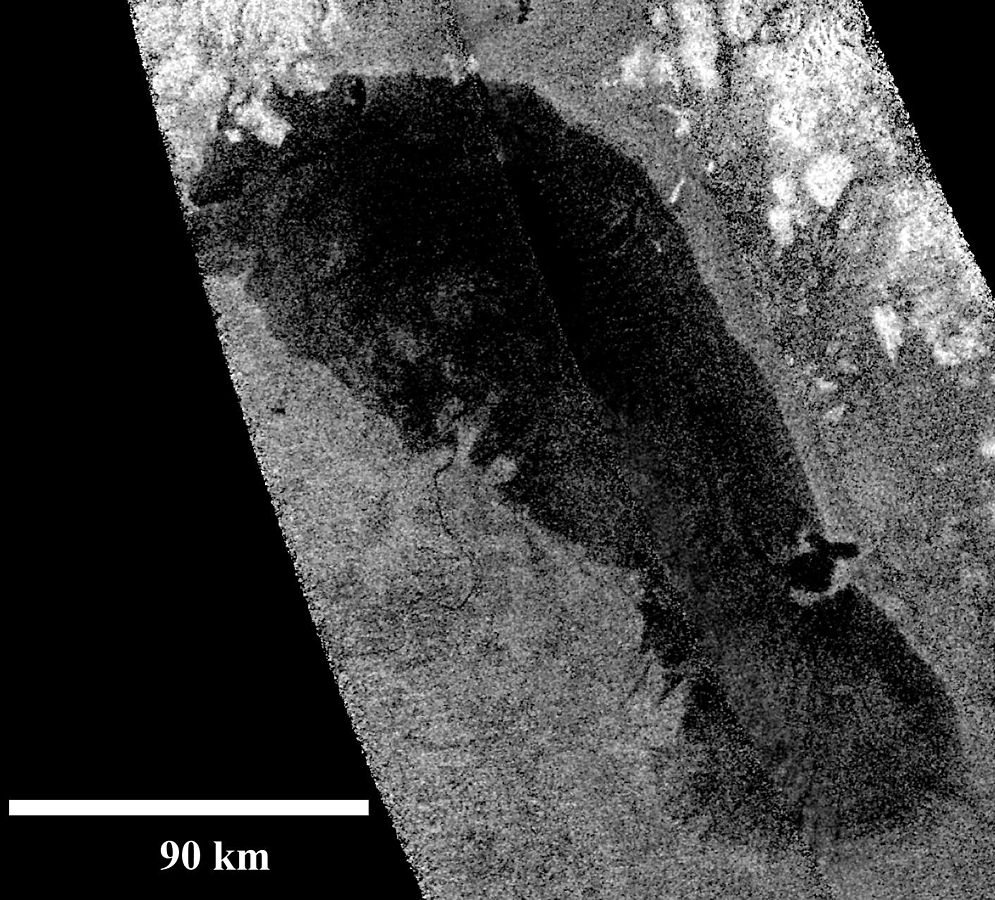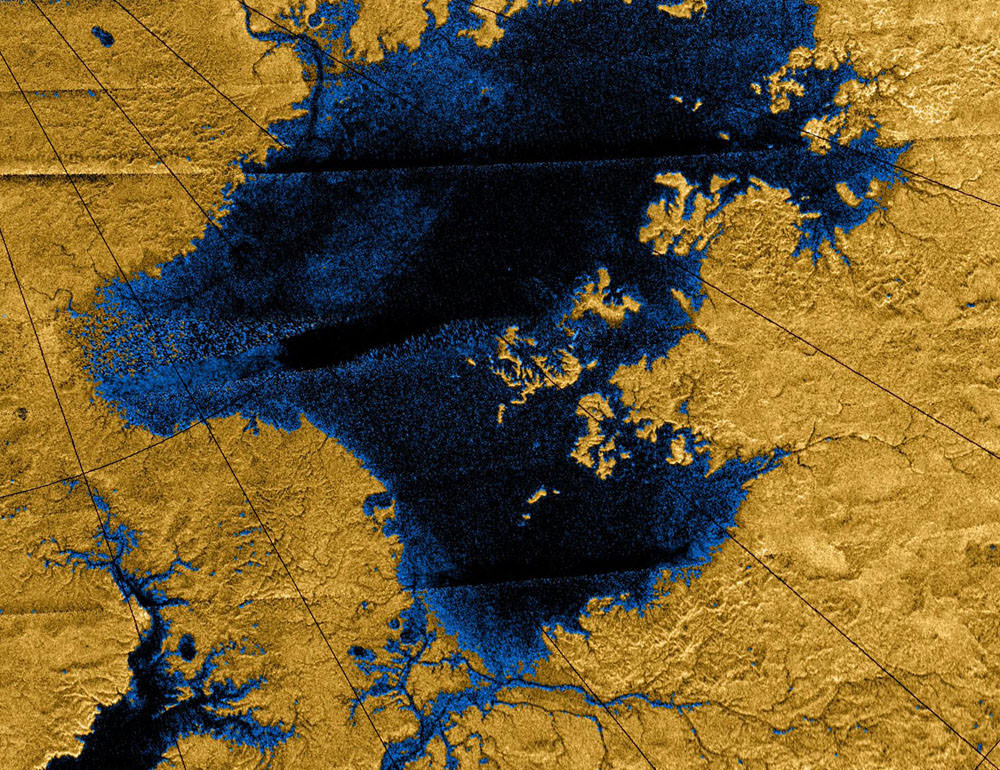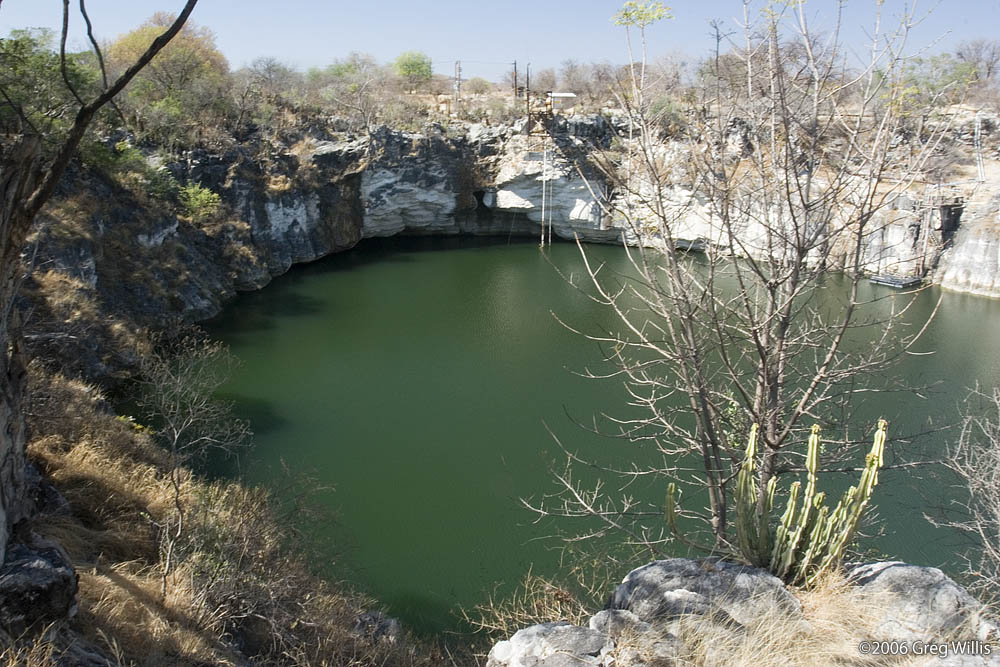The Cassini mission to Saturn and its moons wrapped up in 2017, when the spacecraft was sent plunging into the gas giant to meet its end. But there’s still a lot of data from the mission to keep scientists busy. A team of scientists working with Cassini data have made a surprising discovery: Titan’s methane-filled lakes are much deeper, and weirder, than expected.
Titan is an unusual world. It’s the only body, other than Earth, that has liquid on its surface. Scientists suspect that some of the Solar System’s other moons, like Enceladus and Europa, have liquid oceans. But those oceans are subsurface water oceans. Only Titan has lakes of liquid hydrocarbons.
During Cassini’s final flyby of Titan, it aimed its radar at some of the moon’s liquid lakes. The data shows that those lakes are up to 100 meters (300 ft) deep. The data from those final days also sheds new light on Titan’s hydrocarbon cycle.
The study detailing these results comes from two papers published in Nature Astronomy. The first is “Deep and methane-rich lakes on Titan.” That study features lead author Marco Mastrogiuseppe, Cassini radar scientist at Caltech in Pasadena, California. The second study, called
“The case for seasonal surface changes at Titan’s lake district” features lead author Shannon MacKenzie, planetary scientist at the Johns Hopkins Applied Physics Laboratory in Laurel, Maryland.
About Those Deep Lakes
Data from the Voyager probes gave us our first hint that Titan had liquid lakes. But that data was just inferential: it showed that Titan had the right conditions for them to exist. It has to be very cold for hydrocarbons to exist in their liquid state. After the Hubble Space Telescope got going, it gave us direct evidence that the lakes were there, around 1995. Other observations supported the idea, too.
But in the early days of the Titan lakes hypothesis, we weren’t sure if it held lakes or much larger oceans. Cassini arrived at Saturn in 2004, and although it didn’t see any liquid lakes right away, it eventually found them at the poles, where scientists suspected they might exist.

Since then, many lakes and seas have been found on Titan, and there are lots of images of them.
“Every time we make discoveries on Titan, Titan becomes more and more mysterious.”
Marco Mastrogiuseppe, lead author and Cassini radar scientist at Caltech in Pasadena, California.

Scientists have learned a lot about Titan, especially from the Cassini mission. But these new studies are going even further. And they’re telling us much more than just the depths of Titan’s hydrocarbon seas.
We already knew that the northern seas were filled with methane. But scientists were surprised to find that the much smaller lakes there were full of methane as well, where they expected to find ethane, a heavier hydrocarbon. The results shed new light on Titan’s hydrocarbon cycle.
The hydrocarbon cycle on Titan works similarly to the hydrologic cycle on Earth. In both cases, evaporation forms clouds which eventually fall to the surface, forming rivers which flow into hydrocarbon lakes. On Titan, liquid is evaporated near the equatorial regions then deposited as liquid at the polar regions.
“Every time we make discoveries on Titan, Titan becomes more and more mysterious,” said lead author Marco Mastrogiuseppe, Cassini radar scientist at Caltech in Pasadena, California. “But these new measurements help give an answer to a few key questions. We can actually now better understand the hydrology of Titan.”
But Wait. It Gets Weirder.
Titan is just plain strange. It has land features that are carved the same way they are on Earth, but with liquid hydrocarbons. But it’s different in many puzzling ways. The new data shows that the hydrocarbon cycle on one side of the northern polar region is different than on the other side.

On Titan’s western side, there are small lakes, some no larger than 10 miles across. They’re will above sea level, perched atop large hills and plateaus. The data paints an otherworldly image of mesas and buttes protruding hundreds of feet beyond the surroundings, with deep hydrocarbon lakes on top.
Titan’s eastern side, however, features low-lying large seas, with canyons and islands. Why so different?
“It is as if you looked down on the Earth’s North Pole and could see that North America had completely different geologic setting for bodies of liquid than Asia does,” said study co-author Jonathan Lunine, Cassini scientist from Cornell University.
It may come down to the underlying geology. Scientists think that they formed when the surrounding bedrock of ice and solid organics chemically dissolved and collapsed. It’s similar to some Earthly areas in Germany, the US, and other places, where features called karstic lakes form when water dissolves limestone bedrock.

The new data also shows that Titan may feature transient lakes. Both radar and infrared data show these lakes, with their liquid levels fluctuating significantly in short periods of time. Shannon MacKenzie, lead author of
“The case for seasonal surface changes at Titan’s lake district” thinks that seasonally-driven changes explain these transient lakes.
“One possibility is that these transient features could have been shallower bodies of liquid that over the course of the season evaporated and infiltrated into the subsurface,” she said.
Taken together, both papers paint a picture of the hydrocarbon cycle on Titan where hydrocarbon rains feed the lakes, which then are subject to evaporation. But not just evaporation; some of the liquid likely seeps into the subsurface, which would leave reservoirs of liquid hydrocarbons below the surface.
Titan’s surface features are shrouded by the moon’s thick, visually impenetrable atmosphere. The data behind these studies was gathered largely by radar, much of it obtained during Cassini’s final close flyby of the Moon in April 2017. The Cassini team knew this was their last opportunity to look at Titan’s small lakes, and they feel that they made the best of it.
“This was Cassini’s last hurrah at Titan, and it really was a feat,” Lunine said.
Sources:
- Press Release: NASA’s Cassini Reveals Surprises with Titan’s Lakes
- Research paper: The case for seasonal surface changes at Titan’s lake district
- Research paper: Deep and methane-rich lakes on Titan

